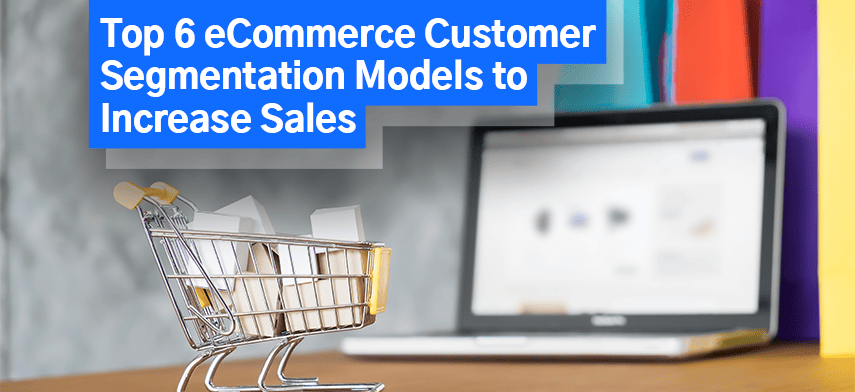The eCommerce landscape is continuously evolving to deliver seamless online shopping experiences. According to eMarketer, the global eCommerce market is expected to reach approx $7.38 trillion by 2025. Indeed, these stats represent countless business opportunities.

However, launching an eCommerce store in an industry where many companies are already competing to gain customers’ attention is not an easy job. You need to consider an array of factors to ensure a successful launch. One of the most important is eCommerce customer segmentation.
Before understanding it in detail, let us see, what is customer segmentation? Customer segmentation refers to the process of dividing your target audience into specific groups or segments based on various aspects such as spending habits, interests, demographic data, and so on.
With this segmentation, you can create tailored marketing campaigns and increase your overall ROI. Your online store gets the privilege to identify core customers, retain existing buyers, and engage new ones faster and better. Altogether, satisfying the ever-changing market demands becomes easier than ever before.
Our today’s blog gives you all the necessary information on how to do customer segmentation and its benefits over other conventional one-size-fits-all marketing strategies. So, let’s dive right in.
The Most Important Customer Segmentation Models for Your eCommerce Business
We have compiled different types of customer segmentation models to help you understand and identify the best ones for your eCommerce business. Let’s check them out one by one.
1 Behavioral Segmentation
As the name suggests, this type of segmentation divides your customers on the basis of their behavior. It is applicable to both existing and future customers.
It focuses on behavioral patterns around how visitors interact with your eCommerce store and what they are willing to buy or browse without any intent to add something to their cart.
This segment thoroughly analyzes customers’ journeys while navigating through your website and determines whether they are highly responsive to pop-ups or prefer exploring the site via banners in particular.
Some of the significant highlights of this model are as follows.
- Interest
This includes what customers are looking for or interested in, especially what brought them to your online store in the first place. It plays a significant role in needs based customer segmentation. It can range from the specialty of your eCommerce mobile app to having certain products onboard. For instance, you can create a group of users who have subscribed to your e-books or newsletters and roll out updates about new product additions accordingly. If you sell packaged drinking water online, you can segregate customers based on preferred brand, mineral content, or container. - Benefits
It highlights the customers that visit your website, make purchases depending on the benefits they get, and keep doing it frequently. Some other considerable factors include engaging with sales and product bundles and responding to exit-intent pop-ups. Basically, many customers are attracted to buying from companies that offer discounts, coupons and deliver products faster via quick commerce. As such, you can create groups based on availed discounts or how often they use coupons. - Usage
It identifies the frequency of visits or purchases and the time that customers spend on your online platform. The eCommerce segments that you can create by considering this aspect include:- One-time customers who have purchased your products only once. You can easily identify these customers by stimulating a query ‘order=1’.
- Review-dependent customers who check out product ratings and reviews (positive and negative) before making a purchase. You need to learn about the buyers who spend the most time on your product review pages.
- Goal-oriented buyers who visit your site with the purpose of finding out a product that perfectly fulfills their requirements like color, size, material, etc.
- Enthusiast browsers who have been visiting your site for a while with no intention to make a purchase. This means they are willing to spend but have some obvious reasons to leave without buying a product.
- Occasion
This eCommerce customer segmentation is all about creating groups that host specific events, thereby bringing customers to your online portal, other than their preferences. It can include important occasions like festivals, parties, weddings, and more. It can also underline events such as the Summer or Black Friday sale. - Engagement
It concentrates on customers’ journeys and their interaction with your eCommerce app. It underlines the latest trends and advancements where customers need proper help and guidance to purchase a product. - Loyalty
It features customers who are or have been loyal to your online retail business. The list may include those who seek VIP tiers or loyalty programs. You will be able to identify brand advocates or even high-value, lifelong shoppers.
2 Geographic Segmentation
This is a customer segmentation strategy that can be implemented even before a visitor interacts with your site. It helps you create groups by considering various geographical and regional characteristics. It can be broken down to include a particular city, town, or area where your customers live or work.
To put it simply, here are the key factors that define geographic segmentation.
- Location
The physical location of your customer base, including country, state, city, or even ZIP code, can majorly influence their consumption habits and preferences. It can range from the scope of your targeted marketing and the size of your business to available resources (delivery schedules and options). - Time Zone
Most countries will try adhering to the same time zone. However, when it comes to larger countries like the US, you may have to deal with many time zones. If you regularly offer time-sensitive products and service deals, then you should never underestimate the importance of time zones. One of the best customer segmentation examples for this may include the tourist season when businesses start initiating campaigns for tourists and slow down their marketing efforts toward native customers. - Weather
The changing weather is another important factor to watch out for in order to create segments that deliver personalized experiences. It determines seasonal products that are only relevant for a specific duration or weather conditions. For instance, if you sell raincoats and a particular area is about to experience heavy rains, you can optimize your campaigns (suggesting a raincoat purchase) and target customers accordingly. - Culture
As an eCommerce business owner, you should never miss out on cultural preferences to understand customer conduct in the context of social behaviors, traditions, and attitudes dominant within the community to which they belong. This will help you improve your marketing strategies alongside avoiding any kinds of backlash or loss of business opportunities. - Language
Your geographic user segmentation model should give enough priority to language preferences. For example, sending emails in one language to a bilingual or multilingual area will pose a lower engagement and conversion rate. Hence, it is imperative to perform A/B testing to gain a stronghold across different languages and plan your marketing strategies accordingly. - Population
This factor defines the density of the population for a particular region. It helps to optimize your marketing efforts depending on the type and size of the audience you aim to target, including rural, suburban, or urban.
3 Psychographic Segmentation
Psychographic eCommerce customer segmentation is all about creating a separate customer base by recognizing their unique set of attributes. These attributes play a vital role in influencing their buying decisions. Unlike behavioral segmentation, these decisions taken by customers are persona-based. This type of segmentation is opposed to surface behavioral patterns.
Some of the key habits and traits to count on include:
- Personality
Some brands or products have the potential to target certain personality types in comparison to others. For example, some customers will get attracted to emojis, while others may keep vibrant colors as their topmost priority before making a pick. Some customers may pay attention to detail, whereas others will seek quality. - Lifestyles
Your brand, products, and services should have the ability to understand and adjust according to different lifestyle profiles like innovators, thinkers, achievers, experiencers, believers, strivers, makers, and survivors. - Hobbies
Keeping a track of customers’ hobbies can prove beneficial for eCommerce businesses trying to create a niche across diverse areas. Some key examples of customer segments for these companies may include book reading, playing video games, collecting antique materials, and hiking. - Values and Attitudes
Morality and social appeal can make a big difference for some customers. For instance, many customers may go for cause marketing, while some may get aligned with brands that dedicatedly work for a particular cause. The important areas to consider may include charity, recycling, carbon neutrality, and much more.

4 Demographic Segmentation
Demographic customer segmentation in eCommerce helps companies in grouping existing and potential customers via certain universal attributes. With these attributes, you have the risk of taking a deeper dive in the first attempt. But with proper implementation, they can maximize your marketing productivity by 2X. They can be of paramount importance while planning and executing national and international operations. For instance, an online retail startup may get exposure to retail customer segmentation in order to handle multiple requests for large territories.
Let’s check out the most common universal traits to give you a better idea.
- Age
Instead of specific ages, your company can divide your customer base by age groups. For example, segmenting customers between ages 18 to 25 will typically represent the young adult audience. - Gender
You can make individual groups of customers, whether they identify as male, female, or gender fluid. This will help you come up with better-targeted marketing strategies. If you are an online clothing store that sells both female and male apparel, then you can push your female-based brands to get aligned with customers who identify as female. - Education
Another trait that needs quick attention to make the most out of your demographic eCommerce customer segmentation is education. Some companies may cater to customers who are pursuing or have completed higher education. On the contrary, there may be products and services that satisfy the requirements of customers who are not engaged with the same. For instance, customers who have a degree might work in an area that helps them earn well and spend on formal wear. - Income
A particular set of brands, services, or products may be accessible to customers with higher incomes. On the other hand, some products might only be marketable to shoppers with much lower incomes. - Profession
A profession is one of the most important universal attributes that are a must to boost your customer segmentation eCommerce outcomes. Customers working across different industries may resonate with a different combination of products and services. The situation will remain the same for those who are at different career levels. Indeed, it focuses on income, but the industry in which the customers are working is equally important. For instance, high-paying professionals may look for an expensive smartwatch, whereas design executives working with them may consider a tablet as a more valuable asset. - Family
The number of members in a particular family can influence marketing decisions and their related outcomes because some products and services are only marketable to customers with families. For example, a couple with two or more children may seek trip packages showcasing family outings, while a young couple may be interested in a package filled with a busy itinerary and enough sightseeing.
5 RFM Segmentation
It is a client segmentation strategy that groups customers on the basis of recency, frequency, and monetary value (RFM) of their purchases from your eCommerce store. It can be used by brands that cater to various customers. For instance, a company can target customers who recently purchased a product because they have the highest purchasing power. Later, they can analyze the RFM data to deliver tailored campaigns or generate rewards.
Here are the prime aspects to rightly implementing this type of online customer segmentation.
- Low Value
Not all your marketing efforts and deals will pull in customers that are bound to establish long-term relationships. You will always come across customers with a single, low-order value purchase. These buyers may have visited your website with the help of promo codes or other marketing collateral, but they are unable to generate value. - Potential Core Customers.These include new and prospective customers. While new customers showcase first-time buyers with a standard order value, prospective customers are the ones who have been repeatedly buying from your eCommerce store.
- Core CustomersYou need to identify core customers to launch a successful RFM segmentation strategy. These customers may include loyalists who spend decent amounts of money to purchase from your brand on a regular basis. They might also outline big spenders as well as champions. Big spenders refer to customers who purchase with the maximum order value. Champions are customers who regularly spend to purchase their preferred products irrespective of their costs.
- Active
It is a group of customers who have recently purchased some items for your eCommerce application or website. In other words, you can consider them active. Besides, there is a high chance of making them repeat customers without putting any sort of constant purchase pressure. - Drifting Like active ones, these customers also refer to a segment that has recently purchased from your brand. The only difference is that they have fallen out of your list of active customers, and you need to drive them back to your platform with targeted marketing.
- Churn Risk Another aspect that can help your brand successfully execute RFM eCommerce customer segmentation is churn risk. These are nothing but customers who have purchased long back and have now started to forget about your brand. In such a context, many companies try to introduce special offers and discounts through their loyalty programs. But you need to experiment and figure out what works best for your marketing model by balancing your product margins with discounts in particular.
- Lost
It is a segment in which customers have reached far beyond the line of churn risk and drifting. It is also known as a polarizing customer segment that is much away from being active. Reconverting such customers is nothing less than a challenge. You need to invest an ample amount of time, effort, capital, and other resources to get them back on track. However, most companies believe that this segment is not worth the effort.
6 Technographic Segmentation
Last but not least, there is technographic segmentation which envelopes customers based on the technologies they use. You can take full advantage of such customer segmentation strategies only when you have a brief idea about the role technology plays in the lives of your target audience. In a nutshell, the major take here is to identify whether a particular customer is tech-savvy or not. Gathering this information will help you improve your product development and customer retention by all means.
Technographic eCommerce customer segmentation is applicable to brands that have rolled out products and services showcasing advanced features and functionalities or use cases that require high technical skills.
Here is a quick overview of the parameters to keep in mind while creating technographic segments.
- Operating Systems (OSs)
This is an important parameter that determines customers’ likelihood to make a purchase. iOS users will have different spending power as compared to customers that rely on Android. - Device
You need to create individual groups of your target audience based on the devices they use, such as laptops, desktops, smartphones, or other mobile devices. This will help you understand the buying habits of your customers and ensure good order-to-delivery experiences.
The Final Words
Knowing which type of eCommerce customer segmentation is best for your brand is really important to wow customers and employ result-oriented marketing strategies. While behavioral segmentation is good for data analysis and adapting to customers’ journeys in real-time, geographic segmentation creates a win-win situation for brands that do not have a clear idea about their target market.
On the flip side, physiographic segmentation enables marketers to serve core customers and attract new ones. You can also go for demographics for niche targeting or evaluate technographic features to keep your app or website up and running in accordance with the latest technology advancements. If you are still confused about the best-fit customer segments for your eCommerce store, you can outsource your requirements to Mobisoft and boost your online sales with ease.

Author's Bio

Nitin Lahoti is the Co-Founder and Director at Mobisoft Infotech. He has 15 years of experience in Design, Business Development and Startups. His expertise is in Product Ideation, UX/UI design, Startup consulting and mentoring. He prefers business readings and loves traveling.


